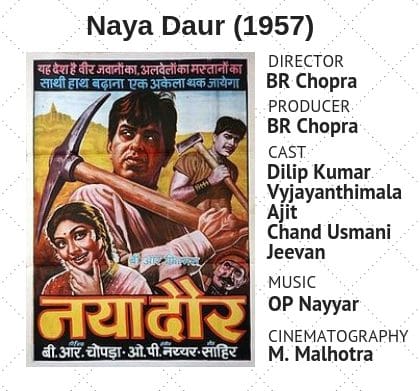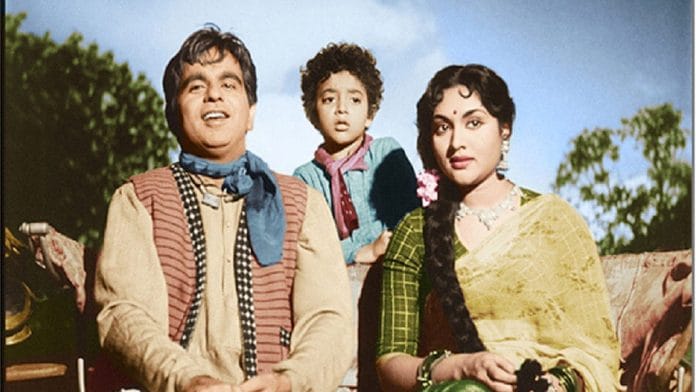As India and the world are dealing with rising automation and trying to figure out if it’s a threat or a boon, a Hindi film more than 60 years ago attempted to answer it. In 1957, Baldev Raj Chopra did a stellar job of putting the “man vs machine” battle at the heart of his now classic film, Naya Daur, starring Dilip Kumar and Vyjayanthimala. At a time when humankind is beginning to look into the ‘moral’ side and the perils of artificial intelligence, BR Chopra’s Naya Daur posed a similar puzzle by pitting human labour (tonga-pullers) against the use of machine (bus).
 The second highest grossing film of the year of its release, after Mother India, Chopra’s Naya Daur takes merely one frame to explain the inevitable position of human labour in a mechanised world, through a quote by Mahatma Gandhi:
The second highest grossing film of the year of its release, after Mother India, Chopra’s Naya Daur takes merely one frame to explain the inevitable position of human labour in a mechanised world, through a quote by Mahatma Gandhi:
“We are all leaves of majestic tree whose trunk cannot be shaken off its roots which are deep down in the bowels of the earth. In this there is no room for machines that would displace human labour and that would concentrate power in a few hands. Labour has its unique place in the cultured human family… Dead machinery must not be pitted against the millions of living machines represented by the villagers scattered in the seven hundred thousand villages of India… The present use of machinery tends more and more to concentrate wealth in the hands of a few.”
https://www.youtube.com/watch?v=VePyuLWBXhw
Also read: B.R. Chopra — the man who shaped our Sunday mornings with Mahabharat
This sets the precedent for the rest of the film, which captured the Indian audience at the time like no other film because they were seeing the advent of industrialisation in real time as well. Naya Daur tells a simple story. Shankar, played by Dilip Kumar, is a tonga-puller. He is the resident of a village where everyone has a job and people live in harmony. It’s an idealistic society, where the people get proper wages for the work they do — an idea enforced by the owner of the local woodworking factory. Conflict arises when the factory owner’s son returns to the village and brings mechanisation in a bid to develop the village and make the business more profitable. Even as many villagers are put out of jobs, the son goes a step further and introduces a bus service, which threatens the tongawalas, including Shankar. In a fit of anger and after protest, Shankar challenges the owner to a race — his tonga versus the bus.
The film is a classic for many reasons. It perfectly captures the sentiment of the lower income groups during the 1950s and thereafter — not completely anti-machine, but just wary enough. It also stressed on the fact that for a poor person, the bottom line always was to ensure two meals a day for survival. While we are way past the age of industrialisation now, this film still holds relevance in today’s world. Its underlying motifs of capitalism vs socialism, a point of debate among many, make it a relevant discussion in today’s times, especially with an invasive social media.
https://www.youtube.com/watch?v=BeqcIyuNVZI
Also read: Indian trade unions: united in labour cause, divided over RSS ideology
As is with most BR Chopra films, the music is another aspect that really brings the message home. Composed by OP Nayyar and written by Sahir Ludhianvi, songs like Saathi Haath Badhana and Yeh Desh Hai Veer Jawano Ka, became anthems for the labour movement. Also, songs like Maang Ke Saath and Ude Jab Jab Zulfein Teri are iconic romantic songs for couples.
https://www.youtube.com/watch?v=ExpUfE89trk
Labour Day was observed on 1 May world over. While it is now mostly a convenient excuse for people to take a holiday, the day really marks the celebration of wage earners who earned their labour rights decades ago. And it is films like Naya Daur that position themselves firmly in debates surrounding their issues and serve as reminders of the struggle — the struggle of the human spirit, of the common man.






